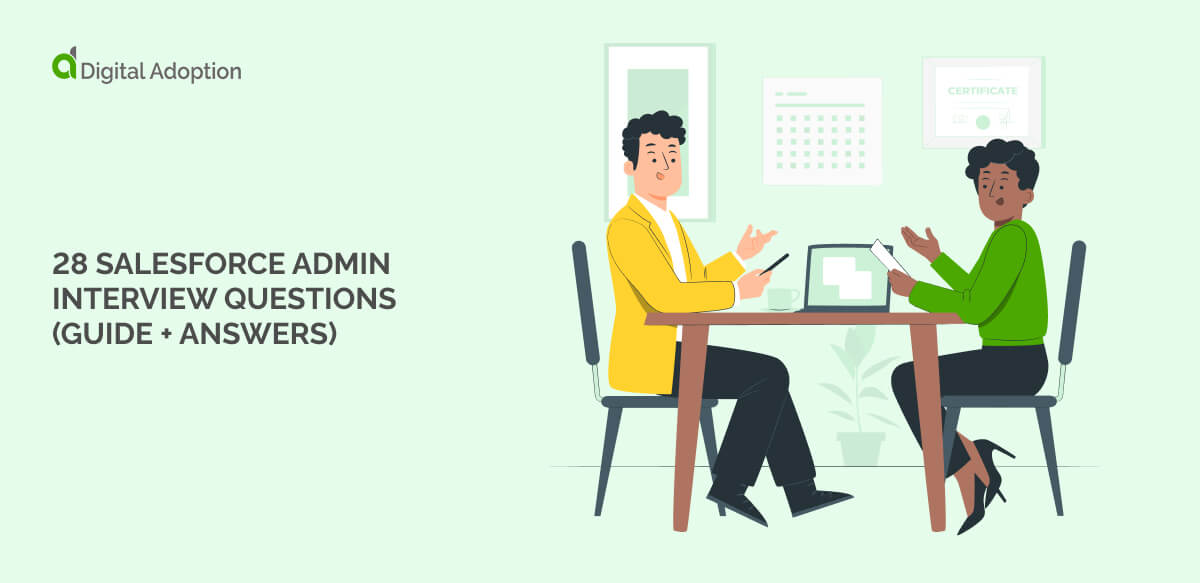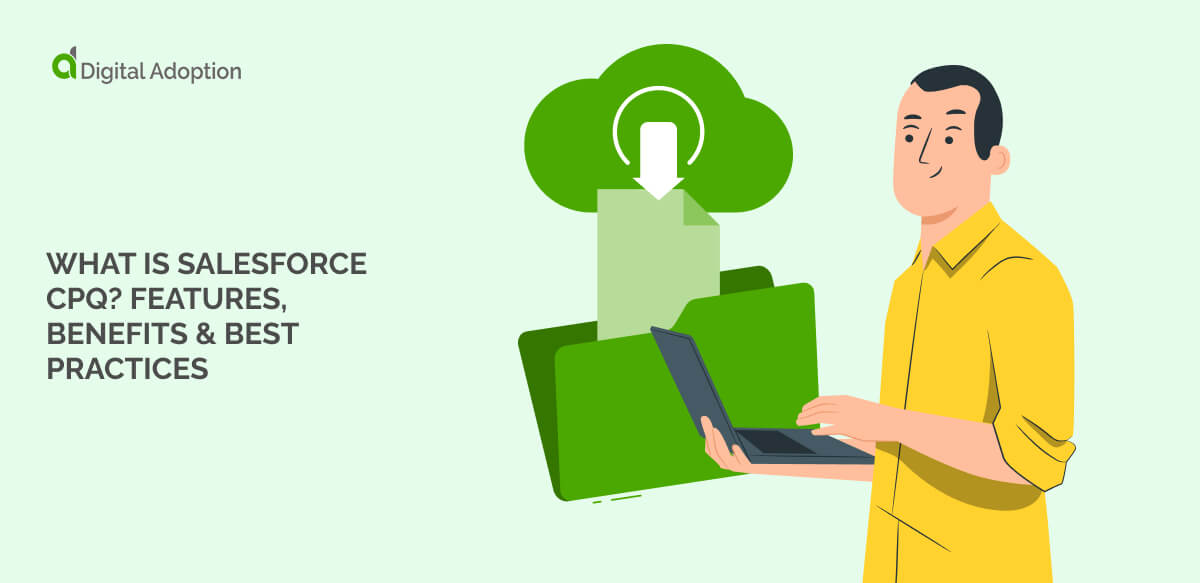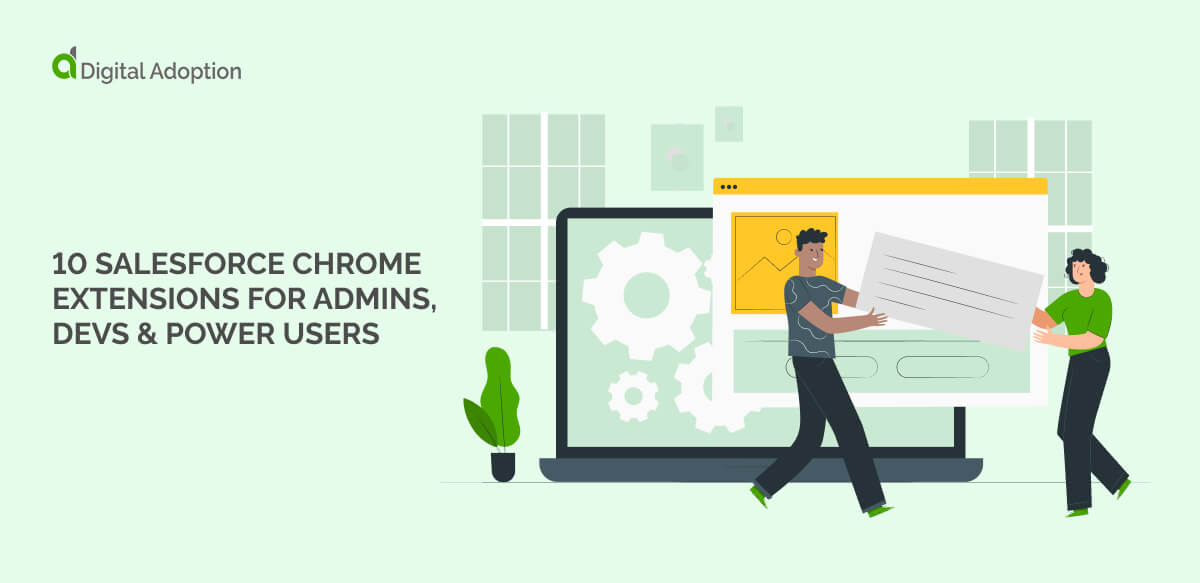The chief product officer (CPO) is essential if you want a reputation as a company that consistently designs products that customers will love as part of customer experience transformation efforts.
The chief product officer collects data, analyzes it, and uses it to build a product roadmap alongside other C-suites to develop products that satisfy customer needs and generate revenue.
The concept of a chief product officer is relatively new, but it’s quickly increasing in popularity as enterprises understand the significance of this role. In 2022, only 15% of Fortune 1000 companies had a CPO, but this doubled in 2023 to 30%.
Now is the time to acquire a CPO. This will allow you to get ahead of the curve and compete with market peers while designing better products.
This article begins with a definition to help you understand the significance of the CPO in your product strategy. It will then help you understand the role of the chief product officer, skills and responsibilities, and why this role is essential.
By the end of this article, you will realize what a CPO does and why they are vital in any enterprise to increase revenue and help organizations stay resilient.
What is a chief product officer?
A Chief Product Officer (CPO), also known as the VP of Product or Head of Product, is an executive who leads the entire product pathway of an organization.
The CPO is responsible for strategic product direction, which encompasses product vision, innovation, design, development, project management, and marketing, along with the chief marketing officer (CMO). The CPO oversees many tech companies’ distribution, manufacturing, and procurement.
The Chief Product Officer is essential because they ensure competitive advantage and growth for the organization to generate higher revenue.
Understanding the chief product officer role
The Chief Product Officer (CPO) is crucial for aligning product strategy with business goals, collaborating with stakeholders to understand market trends, customer needs, and competitive landscapes, and creating a long-term product vision.
They oversee the entire product development lifecycle, ensuring timely, high-quality delivery and a clear roadmap that increases revenue and reduces the annual customer retention cost.
The CPO prioritizes exceptional user experiences, conducts thorough market research to inform product positioning and pricing decisions, and collaborates with various departments to drive coordination and achieve shared goals.
CPOs are essential because they strive to achieve customer success. Customer success is vital because it leads to organizational success when revenue increases after customers buy products and become loyal to a brand.
Chief product officer skills
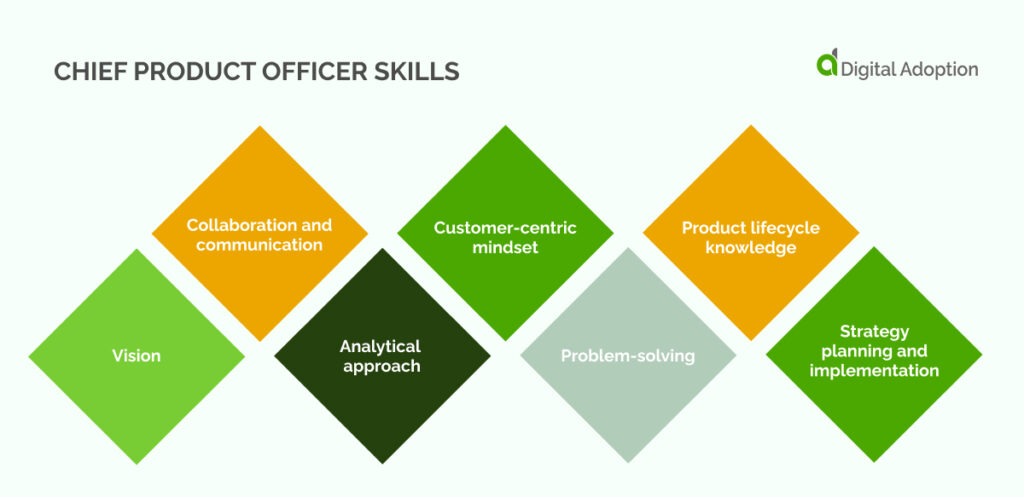
The chief product officer demonstrates various skills relevant to their role. These skills range from generic C-suite skills like strategic planning and a solid vision to more role-specific ones like product lifecycle knowledge and a customer-centric mindset.
Vision
As the head of the product department, the CPO crafts the product’s vision. This vision requires long-term thinking and creating a strategic plan for the product’s future, known as a product roadmap, with clear guidelines for implementation.
When creating a product vision, Chief Product Officers (CPOs) must consider market trends, customer needs, competitive landscapes, and technological advancements. They acquire data from market research, customer feedback, industry reports, and competitor analysis.
CPOs must be capable of building a coherent product vision, which is crucial for guiding the development process and ensuring alignment with organizational goals and market demands.
Collaboration and communication
Building a product involves extensive work among cross-functional teams. Therefore, the CPO must advocate for their team members, motivate the team, and lead collaboration with external teams to ensure successful outcomes.
The Chief Product Officer promotes collaboration and strong communication by fostering open dialogue, setting clear goals, organizing regular team meetings, encouraging feedback, facilitating cross-functional workshops, using collaborative tools, and maintaining transparent communication channels with all stakeholders.
Analytical approach
A CPO must delve into data, analyze data sets, and interpret them to develop data-driven strategies. An analytical mindset also aids in identifying product trends, understanding customer needs, and assessing product performance.
CPOs use analytical skills to:
- Set KPIs: Establishes measurable targets to track product team performance.
- Conduct market research: Gather data on industry trends and customer needs.
- Analyze customer feedback: Review user input to identify improvement opportunities.
- Optimize product features: Adjusts functionalities based on data insights and performance.
- Ensure alignment with business goals: Aligns product strategies with overall company objectives.
These actions support informed strategies and successful product outcomes.
Customer-centric mindset
A CPO should be a product’s strongest advocate. A significant part of that advocacy is customer-focused.
Examples of how a CPO demonstrates their customer-centric mindset include:
- Leading initiatives to conduct in-depth user research and surveys to gather insights into customer needs and preferences.
- Prioritization and implementation of changes based on customer feedback ensure that product updates and features directly address user pain points and enhance satisfaction.
- Regular engagement with customers through feedback sessions, support channels, and user communities, showing commitment to understanding and meeting their evolving needs.
Every action a CPO takes should aim to improve products and ensure customer satisfaction and engagement. Therefore, they must consistently stay attuned to customer needs and complaints, using this feedback to create exceptional products.
Problem-solving
CPOs face daily challenges, including executive team dynamics, company politics, and typical product development issues. Regardless, a CPO must handle problems with a clear and composed approach.
- Customers provide negative feedback about a new product feature.
- Limited resources, such as budget or talent, hinder product development.
- The executive team has conflicting priorities, causing delays in product development.
Although CPOS need to be skilled at solving everyday problems, the more important skill is being agile in their approach to new problems so they can react quickly, maintain product roadmap trajectories, and achieve success.
Product lifecycle knowledge
Product lifecycle knowledge is crucial for a CPO as it ensures efficient product development, from ideation to market launch. This expertise helps the organization optimize resources, predict market trends, and enhance product quality.
For example, understanding lifecycle stages enables the CPO to manage product updates effectively, address customer feedback promptly, and phase out underperforming products.
Such knowledge is essential during new product launches, product pivots, and scaling successful products to ensure sustained enterprise success.
Strategy planning and implementation
In addition to mapping and crafting the product vision statement, CPOs must oversee the entire product lifecycle, transforming ideas into reality. This process involves defining several elements, including:
- KPIs for the product team.
- The technological framework for product development (in collaboration with the CTO).
- The A CPO partners with the CMO to ensure cohesive brand messaging and adapts the digital business strategy, ensuring marketing success.
They also decide on changes to a product’s prototype and approve iterations of existing products.
Consider these skills when you hire a new CPO or compare them to those your current CPO demonstrates. Use the results to support them in improving their existing skills and helping your organization thrive.
Chief product officer responsibilities
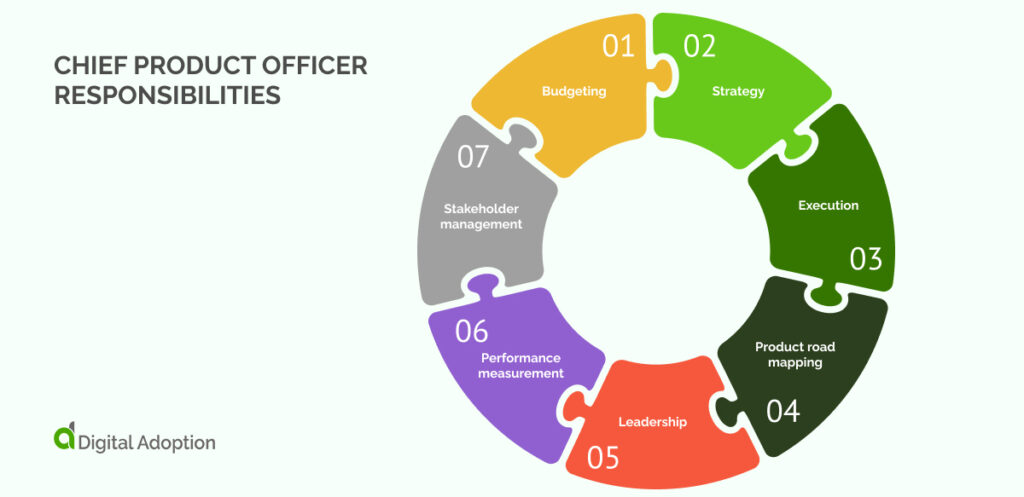
Chief products hold various essential responsibilities to ensure product success. From budgeting to strategy to the soft skills necessary to achieve goals, the CPO must fulfill its commitments to ensure that every new product satisfies customers and shareholders to maintain organizational success.
Budgeting
The CPO is responsible for establishing the budget to keep the product competitive. They collaborate with the CFO to secure funding for essentials such as headcount, technology tools, analyst reports, user testing, and more.
Additionally, CPOs oversee the product portfolio’s profit and loss (P&L) and work closely with the CRO to assess how their efforts impact revenue.
Strategy
Although most C-suites are responsible for strategy, the chief product officer holds a distinct role within the executive team. Beginning with developing a product vision and strategy, the CPO guides the product management team to create products that meet both customer and business needs.
The CPO explains the product’s rationale, explaining the “why.” As an executive team member, they are responsible for presenting their strategy to the board and ensuring alignment with the broader executive team.
Execution
The CPO’s role in execution ensures that teams complete projects on time, within budget, and meet quality standards, which drives operational success and maximizes product impact.
Execution is vital for translating strategies into actionable plans and ensuring teams complete product goals efficiently. It involves overseeing project management, allocating resources effectively, and resolving issues.
Product road mapping
Product road mapping provides a strategic framework for product development, helping to prioritize features and guide the team’s efforts. It aligns product development with market needs and the company’s long-term vision.
The CPO creates and communicates the roadmap, sets vital milestones, and adapts plans based on evolving market trends and feedback, ensuring product development remains focused and effective.
Leadership
A CPO also plays a vital role as a leader and mentor within the product organization. They are tasked with hiring skilled directors and managers, ensuring the team has a balanced mix of strengths and roles (such as PMs, UX, product ops, etc.).
Their direct reports typically include a Director of UX, Product Management, Product Analytics, and, increasingly, Product Operations.
As the head of product, the CPO must provide a clear mission by effectively communicating its strategy and presenting a well-defined roadmap to success.
Performance measurement
Performance measurement is crucial for ensuring that product development aligns with strategic objectives and delivers measurable value.
By setting key performance indicators (KPIs) and monitoring relevant metrics, the CPO can track progress, identify improvement areas, and make data-driven decisions. This approach enables the organization to adjust real-time strategies, optimize performance, and achieve better outcomes.
Stakeholder management
Stakeholder management is essential for aligning interests and securing support for product initiatives. Effective stakeholder management promotes collaboration and mitigates conflicts, ensuring all parties are engaged and have the necessary resources to complete their tasks.
The CPO achieves this by maintaining open communication, addressing concerns promptly, and incorporating feedback, which helps build strong relationships and facilitate successful product development.
Why is a chief product officer important?
There may come a time when you ask yourself: Why are CPOs so important? The answer is that the CPO is vital for any modern enterprise for three main reasons. The first of these reasons is that they provide a strong product vision and problem-solving skills essential for every product’s success.
Problem-solving culture
A Chief Product Officer emphasizes understanding the reason behind a product’s design and the problem it addresses. Creating a successful product involves grasping both technological capabilities and user needs.
The CPO bridges the gap between tech expertise and customer focus, ensuring that products effectively meet user demands.
They can also communicate and role-model the importance of problem-solving to team members, team managers, designers, and even other C-suites to promote a culture of problem-solving, reduce wasted time, and increase revenue.
Future-proofing
In tech-first organizations, the chief product officer is typically a key executive team member. The role may differ in traditional, non-tech-centric businesses, but it is becoming increasingly prevalent.
The CPO’s presence is growing across various industries, blending with existing roles such as chief information officer (CIO). Hiring a CPO today can help you future-proof your organization against competitors who hired a CPO long ago, keeping your company resilient and prosperous.
Promoting C-suite unity
As the role of Chief Product Officer is relatively new, defining its scope can be a learning process for both the CPO and the leadership team.
The role is evolving rapidly, often aligning more closely with commercial and marketing teams rather than being a purely tech-centric function. This shift reflects a broader understanding of the CPO’s impact on business strategy.
The CPO is in a perfect position to promote unity and collaboration between themselves and other C-suites, which will lead to efficiency and better products.
This combination of product vision and problem-solving, essential in traditional and technology-oriented organizations and evolving within the C-suite category, is crucial for competitive advantage and organizational success.
Look for soft and hard skills when hiring a chief product officer
Like all C-suites, the chief product officer must hold a combination of soft and hard skills to complete their role successfully. You must consider both sets of skills to get the best person for the role.
CPO hard skills are more prominent, and candidates will likely focus on them in the interview to demonstrate their value.
Hard skills include knowledge of the product life cycle and strategic planning. However, you should also invite the prospective CPO to speak about their soft skills that allow successful outcomes of the hard skills.
Soft skills like collaboration, communication, and a customer-centric mindset are essential for success, as they allow the CPO to gain a perspective on those designing and using products.
Look out for hard and soft skills when hiring a new CPO to ensure they deliver successful products on time and within budget to help your company thrive.

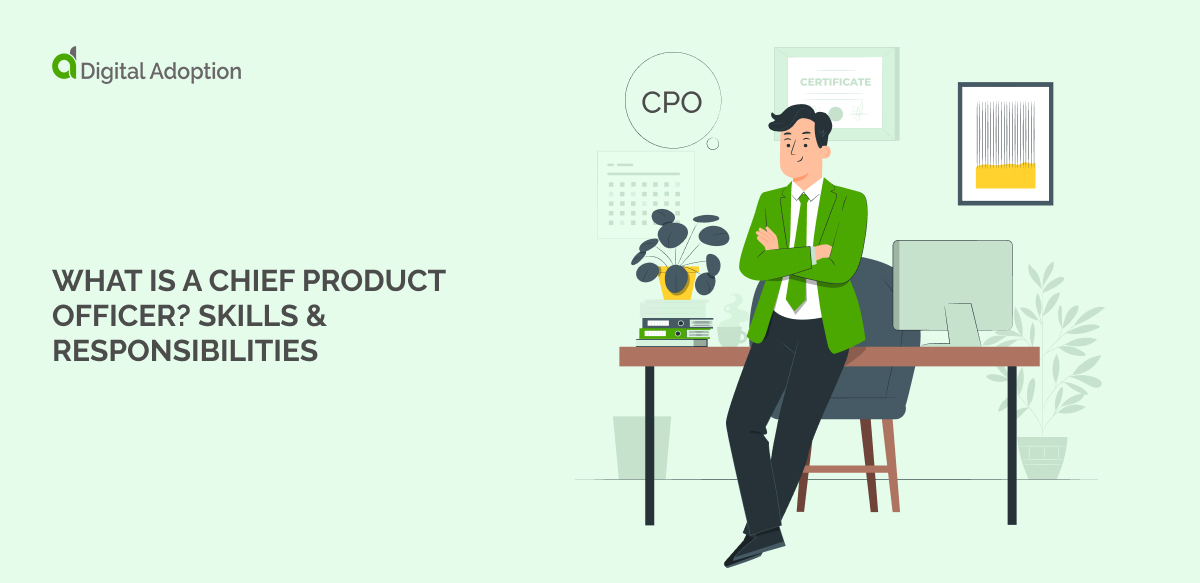






![13 AI Examples in Industry [2025]](https://www.digital-adoption.com/wp-content/uploads/2025/07/AI-Examples-in-Industry-300x146.jpg)


